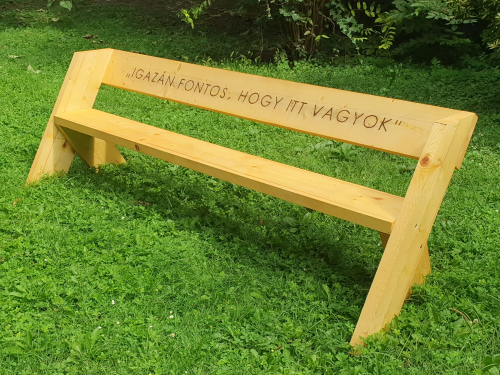The building of the Hungarian Hospice Foundation is an external venue for the exhibition Handle with Care, displaying the works of Anikó Loránt and Tamás Kaszás. The couple created artworks together under the name Ex-Artists’ Collective until Anikó Loránt’s death in 2020. The exhibition was preceded by Ágnes Eperjesi’s 2022 exhibition entitled Meeting Edges, which was the first time to show contemporary artworks within the walls of the Hospice House in Óbuda. This time Tamás Kaszás’s works are installed in the garden as abiding artworks to be used in the treatment of patients, while Anikó Loránt’s drawings have found their due place in the corridors of the institution.
Anikó Loránt graduated from the Intermedia Department of the Hungarian University of Fine Arts in 2003. In her life, her graduation coincided with becoming a mother, which changed her approach to art. Accordingly, the home, the room, the kitchen became her studio, and she started to create smaller works with more accessible materials. She made drawings and watercolours in notebooks and on A/4 sheets and scraps of paper, showing the caring role, the nurturing attitude towards nature and the child’s imagination. Her drawings selected for the Hospice House exhibition feature figurative representations alongside texts that sound like incantations to change the world for the better: “Cheer up!”, “It’s really important that I’m here!” The latter phrase appears on Tamás Kaszás’ Vandalized Aldo Leopold Bench in the garden of the Hospice House.
The bench was designed by the American ecologist, forester and environmentalist Aldo Leopold to serve as a place for contemplation. The bench provides a posture in which, letting go of everything else, one can contemplate nature and the surrounding environment for a long time. Around the bench, Kaszás has placed birdhouses and a bird feeder, which are made entirely of recycled wood (floating wood, discarded planks, trimmings). They contain no metal at all, so that when they age and fall apart they can decompose without harming the environment. The shapes of the birdhouses are reminiscent of Constructivism, including a disc shape alongside angular forms, and are inspired by modernist architecture with a focus on human scale (Le Corbusier) and Lajos Kassák’s “Image Architecture” series. Their interior design and the openings follow the standards set by the Ornithological Association.






























